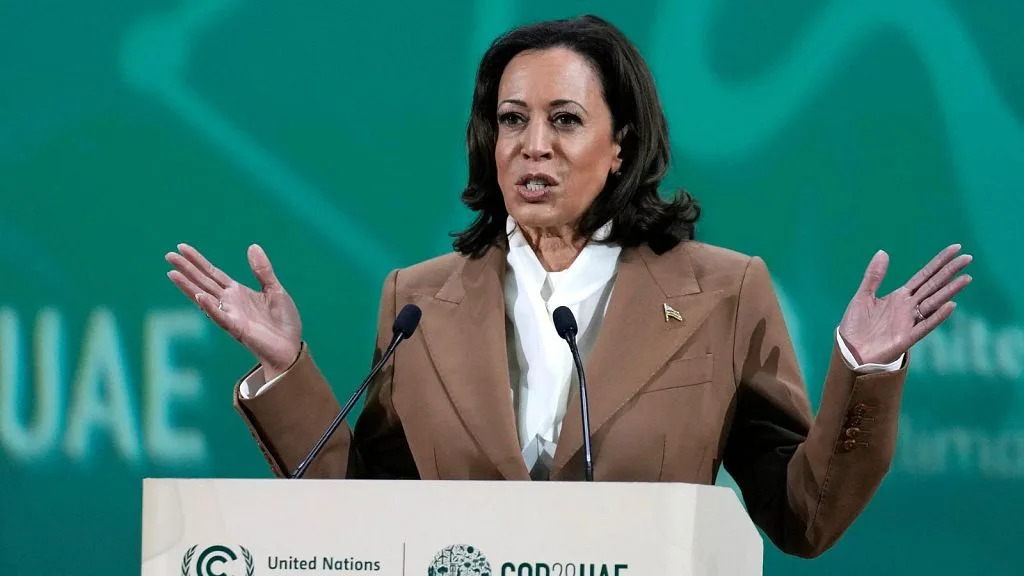Euronews Green
Fri, August 30, 2024

Kamala Harris has said her "values have not changed" on key issues such as climate change during her first major TV interview of this election campaign.
The US vice president is hoping to see off Republic contender Donald Trump in the election on 5 November. President Joe Biden endorsed her when dropping out of the race in July.
As the world’s largest historical contributor to climate change - still the second largest today after China - America’s political direction has huge ramifications for the rest of the planet.
Unsurprisingly this means the vice president’s track record on climate and environmental matters is in the spotlight.
What is Kamala Harris's position on climate change?
With only a few months to go until the election, Harris is unlikely to move far from Biden’s platform.
In an exclusive interview with CNN this week, she said that, despite shifts in her position on topics like fracking during her political career, her values have not changed.
In 2019, Harris said there was "no question" that she was in favour of banning fracking. But during her time in the Biden administration that position changed.
She told the US news channel on Thursday that she has seen that the US can grow and can "increase a thriving clean energy economy without banning fracking", adding that she had made clear in 2020 that she wouldn't ban the practice.
Harris also pointed to the Inflation Reduction Act - which pledged hundreds of billions of dollars in tax subsidies and grants for renewable energy projects - as an example of her climate record. Biden promised it would boost green jobs, support communities on the frontlines of pollution and more.
"You mentioned the Green New Deal. I have always believed - and I have worked on it - that the climate crisis is real, that it is an urgent matter to which we should apply metrics that include holding ourselves to deadlines around time. We did that with the Inflation Reduction Act," Harris said.
Her running mate, Tim Walz, also has a record of climate action in his home state. Last year, as Governor of Minnesota, he signed a law requiring all of the state's power plants to use 100 per climate-friendly energy, such as wind and solar power, by 2040.
A history of climate legislation
Harris would be taking over from a president who is proud of his climate record - and rightly so according to many experts.
In his letter to the nation on 21 July, Biden emphasised that on his watch, America “passed the most significant climate legislation in the history of the world” - referencing the Inflation Reduction Act.
“Biden will leave office with the strongest climate record of any president - making the largest ever investment in clean energy, regulating to reduce pollution from cars & power plants, bolstering clean energy supply chain resilience, & reasserting US global climate leadership,” says Jason Bordoff, founding director of Columbia's Center on Global Energy Policy.
On his first day as president in January 2021, Biden rejoined the Paris Agreement that his rival and predecessor Trump had taken the country out of.

President Joe Biden raises the hand of Vice President Kamala Harris after viewing the Independence Day fireworks in Washington, 4 July 2024. - Evan Vucci/AP
Harris was right there with him (that’s the vice president’s job) and has suggested she will take this green legacy forward. As the US’s top representative at the UN climate conference in Dubai last year, she said the world “must do more” on this vital issue.
At the same time, climate campaigners have criticised Biden’s administration for not doing more.
During his term, the US extended its lead as the world’s largest oil producer, and became the biggest exporter of liquefied natural gas (LNG).
Many environmentalists want to see the Democrats go much further in halting fossil fuel extraction. But are agreed that another four years with Trump at the helm - beside climate sceptic running mate JD Vance - is worth uniting against.
Previous Kamala Harris climate policies
This isn’t the first time Harris has run for president, and her short-lived 2019 bid provides some insights into her thinking - as does her record as California attorney general from 2011-2017.
In that role, she investigated ExxonMobil for misleading the public about climate change. Harris also prosecuted a pipeline company, Plains All-American Pipeline, over an oil spill off the California coast in 2015. And she secured an $86 million (€79 million) settlement for the state from car company Volkswagen for allegations of cheating on diesel emissions tests.
Prior to that, as San Francisco’s district attorney from 2004-2011, Harris created what she called the country’s first environmental justice unit to address environmental crimes (like hazardous waste dumping) against the district’s poorest residents.
"Crimes against the environment are crimes against communities, people who are often poor and disenfranchised," Harris said in 2005. "The people who live in those communities often have no other choice but to live there."
Commentators hope this impressive CV, and framing of pollution as crime, indicates a willingness to get tougher with the fossil fuel industry than Biden has.
Harris’s 2019 presidential bid supports this optimism too.
Back then, she called for a climate pollution fee that would "make polluters pay for emitting greenhouse gases into our atmosphere.” Harris also indicated that America would strengthen its enforcement and prosecution of fossil fuel companies under her leadership.
Another notable milestone on Harris’s climate CV: while serving as a California senator in 2019, she threw her support behind the Green New Deal as an early co-sponsor.
This ambitious blueprint for a green economy, first introduced by AOC and senator Edward Markey, proposed transitioning to 100 per cent clean energy within a decade.
Climate campaigners still believe in this agenda for a just transition and endorsements for Harris have rolled in from groups that see her as a potential ally on issues like climate change.
“We would fall out [of] a coconut tree for someone who ran on this,” Sunrise Movement, a coalition of young climate activists, posted on Instagram, referencing a Harris quote about everyone coming from somewhere rather than simply falling from a coconut tree.
She has so far picked up support from groups including the Sierra Club, the League of Conservation Voters and the Green New Deal Network alongside backing from former US climate envoy John Kerry.


